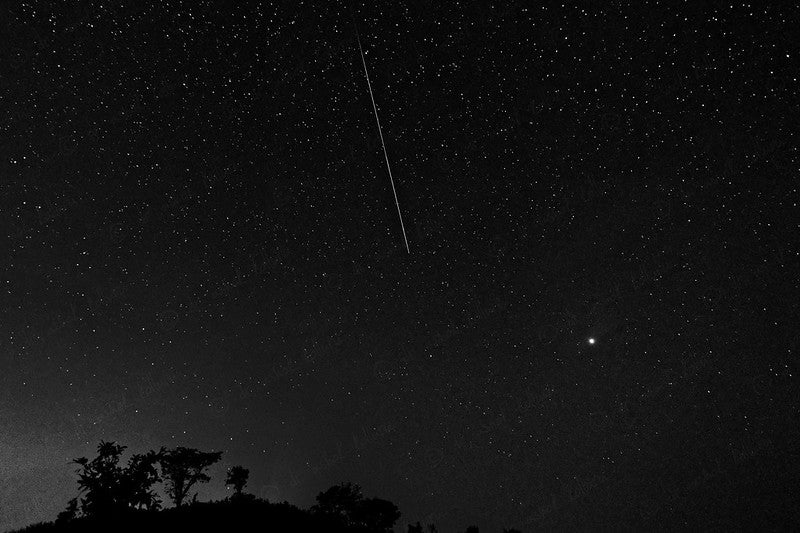
Friday, December 8
Jupiter’s largest moon, Ganymede, is bigger than the planet Mercury. When this icy satellite transits the face of the planet, it’s a sight to see — and one that’s easier to pick up than when, say, smaller Io or Europa make the trip.
Ganymede undergoes just such a transit overnight, beginning early on the 9th for those in the Eastern and Central time zones, but still late on the 8th for those farther west.
Jupiter is visible above the horizon soon after sunset, already some 25° high in the east as the Sun disappears. At magnitude –2.8, it should pop out of the twilight quickly. Once you find it, turn a telescope on the gas giant and you’ll see it surrounded by all four of its Galilean moons, two on each side: Europa farthest east, followed by Ganymede closer to the eastern limb, then Io close to the western limb and Callisto farthest west.
This is a chance to watch orbital dynamics in motion. Stay locked on Jupiter for the next few hours and you’ll see Ganymede closing in on the gas giant from the east, approaching its southern polar region. Over to the west, Io is moving away from the planet while Callisto is moving toward it. Around 9:15 P.M. EST, Callisto stands due north of Io as the two pass; after this, Callisto lies closer to the planet than Io.
Meanwhile, Ganymede keeps approaching Jupiter’s eastern limb, finally beginning its transit at 1:42 A.M. EST on the 9th (again, note this is also the 9th in CST but late on the 8th in the Mountain and Pacific time zones). Ganymede may appear to take several minutes to actually cross onto the planet’s limb, thanks to the moon’s large size. It will take 92 minutes to cross the southern portion of the planet; Jupiter is visible the entire time, though it’s low in the west by the time the transit ends.
Sunrise: 7:09 A.M.
Sunset: 4:34 P.M.
Moonrise: 2:34 A.M.
Moonset: 1:51 P.M.
Moon Phase: Waning crescent (19%)
*Times for sunrise, sunset, moonrise, and moonset are given in local time from 40° N 90° W. The Moon’s illumination is given at 12 P.M. local time from the same location.
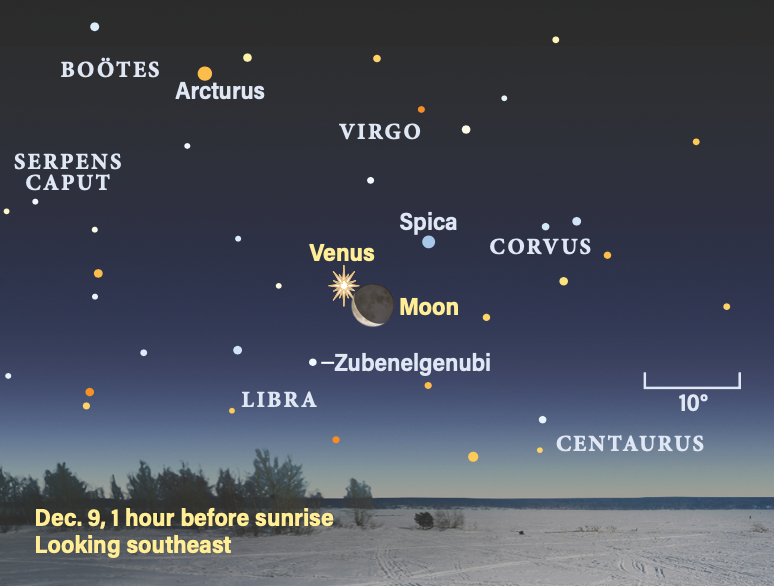
Saturday, December 9
The Moon passes 4° south of Venus at noon EST, but you’ll need to catch these two earlier to observer the meetup.
An hour before sunrise, the pair is a little over 20° high in the southeast, hanging amid the slowly fading stars of Virgo the Maiden. Venus is magnitude –4.1 — you can’t miss it. The blazing planet sits just to the upper left of the 13-percent-lit waning crescent Moon. If it’s still dark enough, you’ll catch Virgo’s brightest star, magnitude 1 Spica, about 11.5° to the pair’s upper right (west).
Through a telescope, Venus appears 71 percent lit and is 16″ across. The Moon, by contrast, only shows off a sliver of its surface under sunlight as lunar night approaches the western limb. However, you may catch some earthshine lighting up the shadowed regions of the disk. This occurs when sunlight bounces off Earth and illuminates the darkened lunar surface with a soft glow, rendering the entire face of the Moon visible, even when most of it is in shadow.
The pair will remain visible even as twilight brightens around them, though make sure to put away any telescope or binoculars several minutes before the Sun is set to rise from your location, which may differ somewhat from the time listed below.
Sunrise: 7:10 A.M.
Sunset: 4:34 P.M.
Moonrise: 3:38 A.M.
Moonset: 2:15 P.M.
Moon Phase: Waning crescent (12%)
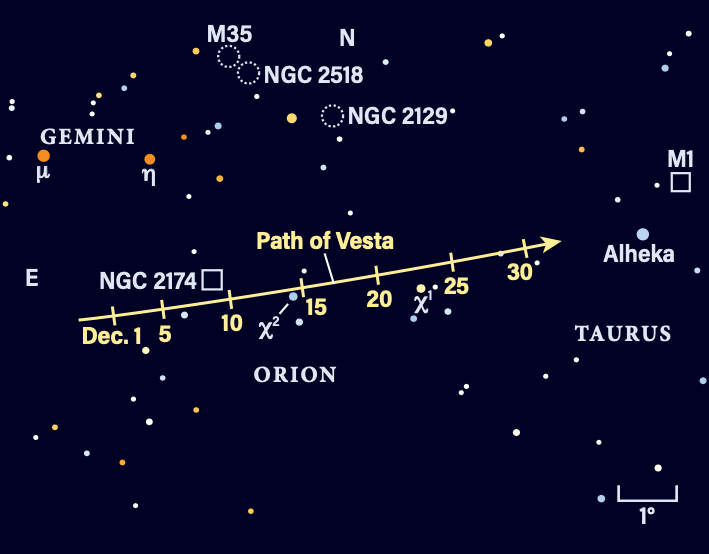
Sunday, December 10
Asteroid 4 Vesta is an easy-to-catch target in Orion the Hunter in the evening sky. Tonight, the asteroid slips just south of NGC 2174, sometimes called the Monkey Head Nebula. Although the nebula is a bit challenging to spot in smaller scopes, the 7th-magnitude open star cluster inside it, NGC 2175, will be easier to pick up. Medium to large telescopes will start to show NGC 2174’s nebulosity under dark skies, and this is a popular astrophotography target if you’re looking to expand your portfolio. And just a few degrees away lies M1, the famous Crab Nebula, if you want to get a little historical observing in as well!
Let’s start by locating this region, which lies in northeastern Orion to the upper left of his bright red giant shoulder star, Betelgeuse. Wait until at least 8 P.M. local time, when the full constellation has cleared the eastern horizon. Find Orion’s Belt — these three stars in a straight line will appear to be standing on end, with Orion lying sideways as he rises. Draw a line from the lowest star in the belt (Alnitak) up and to the left until you land on bright Betelgeuse, about 10° to its north-northeast. Continue that line another 13° or so in roughly the same direction, and that’s where to start your search for Vesta.
Vesta is magnitude 6.7, making it the fourth- or fifth-brightest point of light in the field. It lies ¼° southwest of NGC 2175 and NGC 2714. Just over 1° due west of Vesta is Chi2 (χ2) Orionis; the large main-belt world will pass close to this star on the 14th and 15th.
Keep drifting west and about 6.2° west-northwest of Chi2 is 3rd-magnitude Alheka, the tip of one of Taurus the Bull’s horns. The Crab Nebula is just over 1° northwest of this star. If you can pick it up, the relatively compact, magnitude 8.4 nebula will appear as a fuzzy, thumbprint-like “smudge” against the background sky through your telescope. Like the Monkey Head, M1 will need pretty dark skies to appear in earnest.
Sunrise: 7:11 A.M.
Sunset: 4:34 P.M.
Moonrise: 4:45 A.M.
Moonset: 2:44 P.M.
Moon Phase: Waning crescent (6%)
Monday, December 11
Although the Summer Triangle is setting in the west this evening, with the Sun also setting early the constellation Cygnus is still high in the sky after dark. The Swan’s brightest star, Deneb, lies near the large North America Nebula, cataloged as NGC 7000, making this deep-sky marvel particularly quick and easy to find.
From magnitude 1.3 Deneb, it’s just a short hop 3° due east to the nebula. About 2° across at its widest, this huge emission nebula forms the distinct shape of the continent for which it is named, with its “East Coast” most closely resembling that of the earthly feature. Immediately west of NGC 7000 is a dark swath of dust. On the other side of this divide lies IC 5070, the Pelican Nebula.
If your sky is particularly dark and clear tonight, you might be able to spot this large nebular complex with the naked eye. Binoculars or any telescope will easily show it, with larger apertures gathering more light to bring out more detail. If you have a UHC filter, Astronomy contributor Alan Goldstein recommends slipping that in to reduce the light of stars in the foreground and better bring out the nebula’s glow.
Why are these nebulae so bright? They’re being blasted with radiation from an apparently dim star that lies in the dark region between the two. But this star is only faint because it lies behind a thick cloud of obscuring dust. Without all that dust in the way, it would be one of Cygnus’ brightest stars.
Sunrise: 7:12 A.M.
Sunset: 4:35 P.M.
Moonrise: 5:56 A.M.
Moonset: 3:20 P.M.
Moon Phase: Waning crescent (2%)
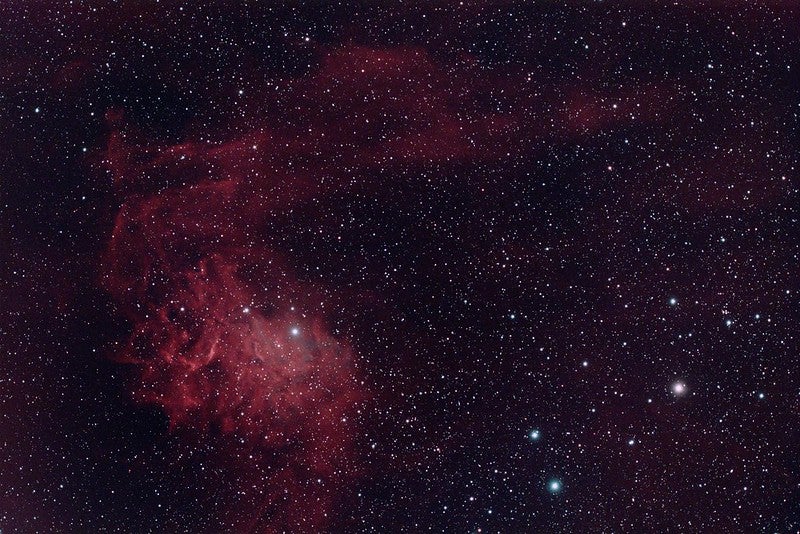
Tuesday, December 12
New Moon occurs at 6:32 P.M. EST, making tonight a great night to hunt deep-sky targets that tend to get washed out in bright moonlight. Let’s try for an object you might not have observed before: the Flaming Star Nebula (IC 405). Located in Auriga, this is both an emission and a reflection nebula lit up by the star AE Aurigae. This 6th-magnitude variable star can appear as faint as magnitude 6.1 or as bright as magnitude 5.4. Even at its faintest, it should be just visible to the naked eye in good skies, and a telescope or binoculars will easily pick it up no matter where it is in its cycle.
Just east of AE Aurigae is the brightest part of IC 405, which itself stretches nearly 40′ across at its widest. According to Astronomy contributor Alan Goldstein, a modern amateur scope as small as 2.4 inches will pick up IC 405 under good skies. Bigger apertures will help, though light pollution quickly washes it away even in larger scopes. But if you’ve got a dark sky and the weather is clear and cold — as it often is in the Northern Hemisphere in December — chances are good you will spot the nebula.
Mercury stands stationary against the stars of Sagittarius the Archer at midnight EST. After today, it will begin moving retrograde, or westward, in the sky as it approaches the Sun, reaching inferior conjunction in just 10 days.
Sunrise: 7:13 A.M.
Sunset: 4:35 P.M.
Moonrise: 7:07 A.M.
Moonset: 4:05 P.M.
Moon Phase: New
Wednesday, December 13
The Moon passes 4° south of Mercury at midnight EST. If you’re quick to look west just after sunset, you may catch the delicate waxing crescent — just 1 percent lit! — very low on the southwestern horizon. Once the Sun has fully set — and only once this has happened — you can turn a telescope or binoculars on the barely one-day-old Moon to see if you can observe its illuminated eastern limb. Once again, you may pick up some earthshine rendering the rest of the darkened face visible, particularly under the magnification of optics.
Some 6.9° directly above it is a small pinprick of light: That’s Mercury, glowing at magnitude 0.2. The planet is just 7° high 20 minutes after sunset, as the Moon is sinking below the horizon. Fortunately, you’ve got a bit more time to spend with Mercury, as it sets just over an hour after the Sun. Now roughly a quarter lit, the planet spans 8″, about half the apparent width of Venus when it sat close to Luna.
To Mercury’s upper left in the sky and sitting due south shortly after sunset is the ringed planet Saturn. It’s the brightest point of light in Aquarius. Wait for the sky to get a bit darker and then make sure to observe this lovely world through your scope. The rings currently stretch just under 40″ and are tilted roughly 10° to our line of sight, rendering their northern face visible. You may also spot Saturn’s largest moon, Titan, about 45″ to the planet’s northeast.
Sunrise: 7:13 A.M.
Sunset: 4:35 P.M.
Moonrise: 8:16 A.M.
Moonset: 5:03 P.M.
Moon Phase: Waxing crescent (1%)
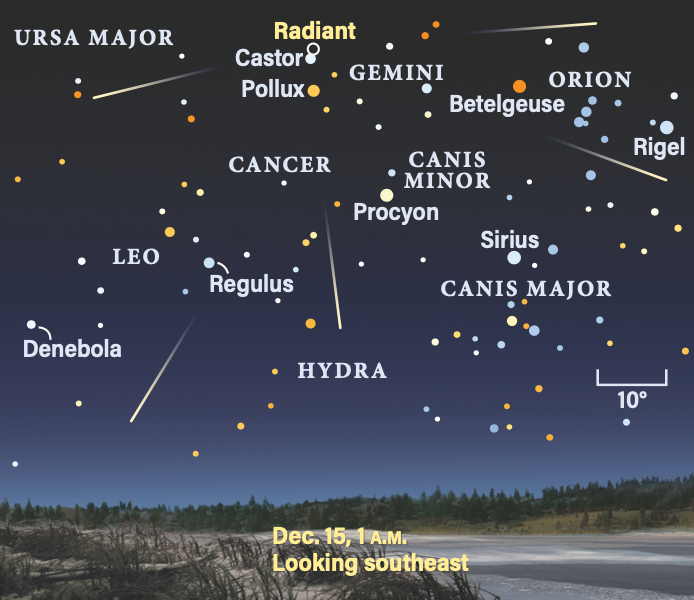
Thursday, December 14
It’s finally time! The Geminid meteor shower, one of the most anticipated skywatching events of the year, peaks overnight tonight as shooting stars appear to stream away from Gemini the Twins.
With the Moon just a thin waxing crescent, conditions are extremely favorable. You can start looking for shower meteors a few hours after sunset tonight, though the best show will occur overnight and into the early morning hours tomorrow as the radiant in Gemini rises higher and your location on Earth rotates into the meteoroid stream.
By 9 P.M. local time, the radiant — located near the bright star Castor — is already 30° high and climbing in the east. Look for Gemini to the left of Orion’s Belt. Two bright stars mark the Twins’ heads: magnitude 1.2 Pollux and magnitude 1.6 Castor. Castor is the higher of the two in the sky, which rise as if stacked one on top of the other.
Once you’ve located the radiant, make sure to scan the sky well on either side of it, in Taurus and Orion to the south, and Ursa Major to the north, near the Big Dipper. This is because the best meteors with the longest trains typically appear farther from the radiant, while those emanating directly from Gemini will leave shorter streaks of ionized gas in the sky because they appear to be approaching you directly.
At its peak, the Geminids may produce up to 150 meteors per hour where the radiant is overhead. The best times to watch for the most meteors in the U.S. will be around local midnight, when the radiant is 65° high and you can expect an average of some 50 meteors per hour. That’s roughly one meteor a minute, though you might see many meteors over a short period, followed by a quieter lull.
Keep an eye on our website early next week for a more details on how to watch this fantastic show.
Sunrise: 7:14 A.M.
Sunset: 4:35 P.M.
Moonrise: 9:17 A.M.
Moonset: 6:11 P.M.
Moon Phase: Waxing crescent (4%)
Friday, December 15
Coma Berenices is high in the southeast in the hour or two before sunrise this morning. One of the constellation’s most famous occupants is the Coma Berenices star cluster (Melotte 111), located just south of 4th-magnitude Gamma (γ) Comae Berenices. This loose grouping of young stars is visible to the naked eye as a fuzzy glow from a dark site, and really pops out in binoculars or any small scope. With a combined magnitude of 1.8, the cluster spans a worthy 4°, making it best for observing under low magnifications.
Now skip about 8.5° southwest of Melotte 111 and you’ll land on the Blackeye Galaxy (M64). This magnitude 8.5 spiral is about 10′ wide at its longest and visible in small to medium scopes as a small smudge of light. It’s only when you bump up to a large scope of 10 inches or more that the name becomes apparent, though. This galaxy sports a dark dust lane, like a black eye — or, at least, William Herschel thought so when he spotted it.
Sunrise: 7:15 A.M.
Sunset: 4:35 P.M.
Moonrise: 10:07 A.M.
Moonset: 7:27 P.M.
Moon Phase: Waxing crescent (10%)

Sky This Week is brought to you in part by Celestron.









